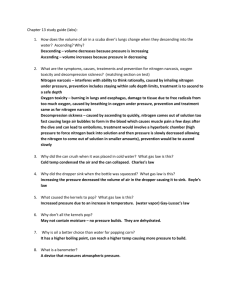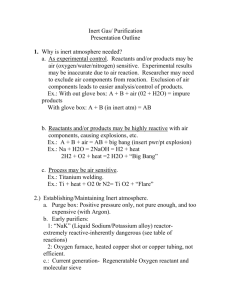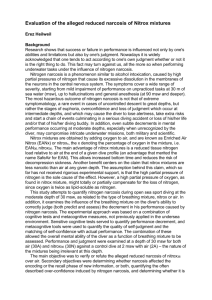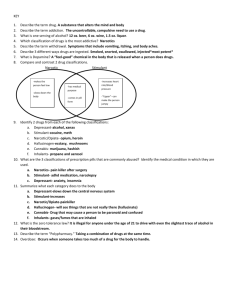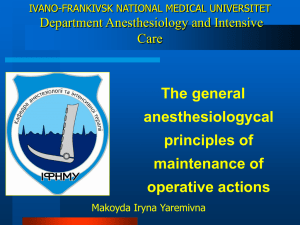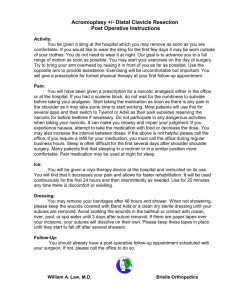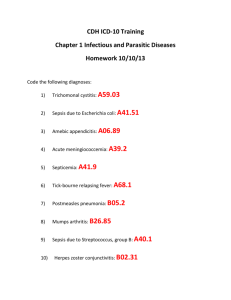Inert Gas Narcosis - Ultimate Dive Log
advertisement
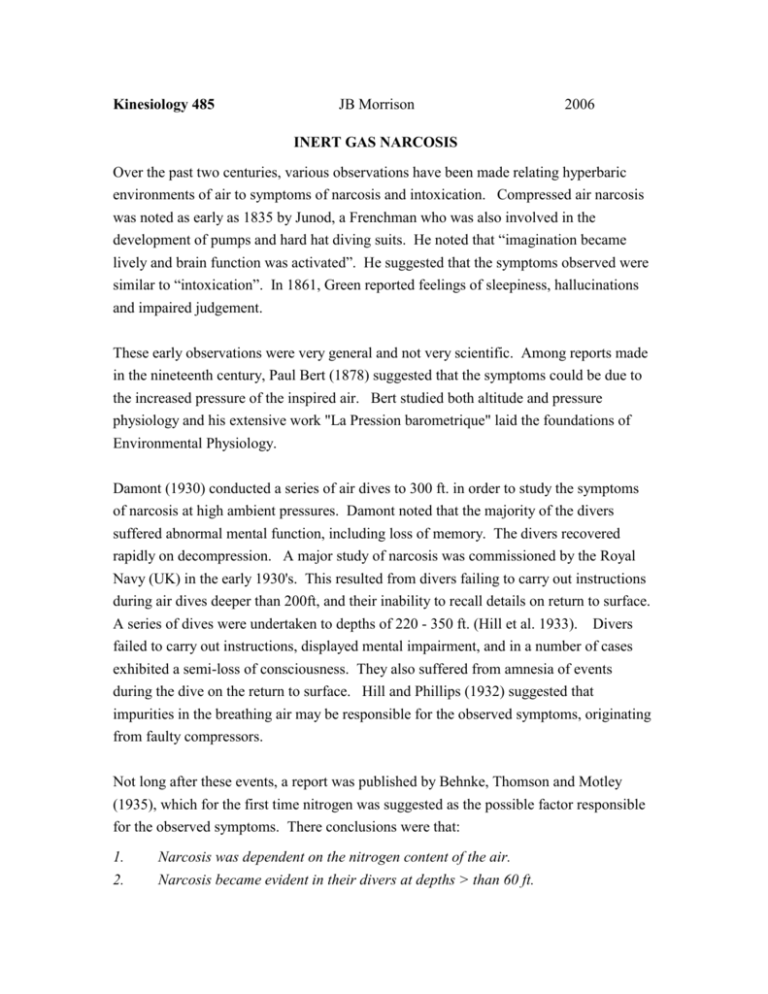
Kinesiology 485 JB Morrison 2006 INERT GAS NARCOSIS Over the past two centuries, various observations have been made relating hyperbaric environments of air to symptoms of narcosis and intoxication. Compressed air narcosis was noted as early as 1835 by Junod, a Frenchman who was also involved in the development of pumps and hard hat diving suits. He noted that “imagination became lively and brain function was activated”. He suggested that the symptoms observed were similar to “intoxication”. In 1861, Green reported feelings of sleepiness, hallucinations and impaired judgement. These early observations were very general and not very scientific. Among reports made in the nineteenth century, Paul Bert (1878) suggested that the symptoms could be due to the increased pressure of the inspired air. Bert studied both altitude and pressure physiology and his extensive work "La Pression barometrique" laid the foundations of Environmental Physiology. Damont (1930) conducted a series of air dives to 300 ft. in order to study the symptoms of narcosis at high ambient pressures. Damont noted that the majority of the divers suffered abnormal mental function, including loss of memory. The divers recovered rapidly on decompression. A major study of narcosis was commissioned by the Royal Navy (UK) in the early 1930's. This resulted from divers failing to carry out instructions during air dives deeper than 200ft, and their inability to recall details on return to surface. A series of dives were undertaken to depths of 220 - 350 ft. (Hill et al. 1933). Divers failed to carry out instructions, displayed mental impairment, and in a number of cases exhibited a semi-loss of consciousness. They also suffered from amnesia of events during the dive on the return to surface. Hill and Phillips (1932) suggested that impurities in the breathing air may be responsible for the observed symptoms, originating from faulty compressors. Not long after these events, a report was published by Behnke, Thomson and Motley (1935), which for the first time nitrogen was suggested as the possible factor responsible for the observed symptoms. There conclusions were that: 1. 2. Narcosis was dependent on the nitrogen content of the air. Narcosis became evident in their divers at depths > than 60 ft. They also observed the symptoms mentioned previously, namely euphoria, excitement, laughter etc. At 100 ft. these narcotic effects could be counteracted, but at depths of 300 ft. the divers had significant retardation of mental processes, decreased response to sensory stimuli and impaired neuromuscular co-ordination. These symptoms did not alter with time spent at depth. In general, the effects of increased air pressure have been noted to decrease the performance of a diver in the form of: 1. Slowing of mental activity 2. Increased number of errors in a task such as data recording, mental arithmetic or fine movement Increased response time to stimuli Impaired memory. 3. 4. These symptoms are not alleviated with time and resemble those of hypoxia, intoxication and anaesthesia. The observed “narcosis” is potentiated by fatigue, hard work, apprehension and carbon dioxide. Cousteau has also suggested that individuals who are emotionally less stable will be more susceptible to the narcotic effects of compressed air diving. There has been a great deal of experimentation on the performance effects of narcosis in order to quantify performance decrement as a function of pressure. Results of many studies reveal a general picture, but there is much conflicting material due to the complexity of symptoms, the different methodologies employed and the variance of effects among subjects. Factors affecting outcome include: 1. Motivation of the diver 2. 3. 4. 5. 6. Experience; learning to cope, concentrate and recognise Individual variations Type, age, and training of the diver Temperature Proliferation of procedures, and tests which are not directly comparable or standardised Learning of the task 7. Summary of Effects: <60ft. no noticeable effects. 100ft. perceptible decrement which is significant. 150ft. moderate impairment. 300ft. severe impairment, stupefaction, totally incompetent. 400ft. symptoms resemble psychedelic drugs (Californian high), losing consciousness . Martini Law: effect = 1 Martini / atmosphere air pressure An example of the effect of N2 narcosis on mental performance is shown in Fig. 1. Divers performed a timed 2 x 1 multiplication test at surface and at 100 ft breathing air. Their "score" is adjusted for the number of sums attempted and the number of errors. Table 1 shows the results of a number of performance measures repeated at progressive air depths from surface to 300 ft. Interactions of Other Variable With N2 Narcosis: There is now sufficient evidence to conclude that the increased partial pressure of N2 is the principle cause of compressed air narcosis. When the N2 component of air is replaced by Helium or Neon, the symptoms of narcosis are absent or reduced (see Fig 2 and Fig 3). For this reason, narcosis due to air diving is often termed “Nitrogen Narcosis”. Narcosis may be experienced when breathing other inert gasses, with the effects varying from "mild" up to loss of consciousness depending on the inert gas breathed and its partial pressure. In a diving situation, it is possible that other variables (such as fatigue, hard work, CO2, O2, apprehension, hydrostatic pressure) may interact with the nitrogen narcosis, thereby potentiating (or counteracting) the effects. Most of these variables become increasingly detrimental to the diver's performance if they occur simultaneously. Carbon Dioxide: Accumulation of CO2 is hazardous if allowed to increase in the divers environment, causing confusion and an inability to think clearly, drowsiness and loss of consciousness. Case and Haldane (1941) investigated the effect of elevated levels of inspired CO2 in a compressed air environment. At normal atmospheric pressure breathing 3-4% CO2 there was no significant deterioration in manual or arithmetic skills, but at 10 ATA breathing 3 - 4% SEV* CO2 subjects exhibited marked deterioration in manual dexterity and a good deal of confusion. With 7 - 10% SEV CO2 most subjects lost consciousness at depth. (*SEV: surface equivalent value in terms of partial pressure; i.e. PCO2 remains constant, or PCO2 = 0.03 ATA). Figure 1. Mental Arithmetic Test Scores at Surface and 100 ft: Mean results of 18 subjects breathing air at rest in hyperbaric chamber. The progressive increase in score represents learning at surface, while the decrement in condition 5 represents the effect of nitrogen narcosis at 100 ft. Conditions: 1, 2, 3: practice at surface Condition 4 predive test in chamber at surface Condition 5 chamber dive to 100 ft. Condition 6 postdive test in chamber at surface (Data taken form Kin 485 Narcosis Lab. Results) Exercise: The increased gas density of higher air pressures results in an increase in the divers work of breathing and therefore limits the ventilatory response to exercise. This in turn leads to a rise in the arterial PCO2 of the diver, and to the additional narcotic effects attributable to Carbon Dioxide. Exercise will therefore increase the level of narcosis when compared to resting conditions under the same hyperbaric conditions. This effect is illustrated in Figure. 4. Figure 5 shows the decrement in reaction times and short term memory as a function of PETCO2 in divers exercising at 0.5 and 50 m. In this experiment, most of the decrement can be explained by the rise in PETCO2 due to exercise, rather than by the increase in PN2 at 50 m. Rate of Compression: The rate of compression also affects the onset of N2 narcosis. Allans (1962) reported 12 cases of divers stopping their descent and returning to the surface due to N2 narcosis, where they had previously reached that depth without incident. The common factor from the aborted attempts was the rate of compression. One possible mechanism may be that the increased rate of compression resulted in increased levels of alveolar and cerebral PCO2. Alveolar PCO2 may rise from resting levels by 7-8% on compression to 5-9 ATA returning to normal after 4-8 min. at pressure. If compression is slow (30 min.) this increase in PCO2 is not observed. Hypoxia and Hyperbaric Oxygen: Some symptoms of inert gas narcosis are similar to hypoxia, but at 10 ATA the PO2 is 2 ATA, therefore hypoxia is not likely to cause enhancement of N2 narcosis. Increased PO2 has a toxic effect causing chronic changes in lung pathology, increased excitability of the nervous system and convulsions. At 10 ATA, compressed air has the same O2 pressure as pure O2 at 2 ATA, but at 2 ATA there are no noticeable signs of narcosis. However, there is strong evidence that O2 is does have a narcotic effect if the pressure is sufficiently high; with a narcotic potency estimated to be about twice that of nitrogen. Frankenhaeuser et al. (1963) studied the effect of O2 and N2 on divers at increased pressures. The partial pressures of the two gases was varied, and the result on performance was recorded. Increased O2 pressure, at a constant PN2, significantly enhanced the narcosis effect. Figure 4 Combined effects of exercise, nitrogen narcosis and exercise induced hypercapnia on short term memory (values are mean + SEM). Results of ten divers breathing air at 0.5 and 50 m. Performance decrement in reaction time and short term memory as a function of end tidal carbon dioxide pressure (PETCO2) data measured at 0.5 and 50 metres: SRT simple reaction time cCRT compatible choice reaction time iCRT incompatible choice reaction time mem short term memory Figure 5 Results of four performance tests. The data points for each of the tests are represented by separate symbols for clarity. It can clearly be seen that all four tests showed similar trends when performance decrement was expressed as a function of PETC02. (S. Fairburn, 1993. MSc Thesis, School of Kinesiology, Simon Fraser University) Possible Causes and Mechanisms of Inert Gas Narcosis: These are complex and cannot be related to one single factor alone. Various theories have suggested, for example that narcosis is dependent on the molecular weight of the inert gas, or that the combined effects of hyperoxia and CO2 retention were responsible. Other theories suggest that the inert gas interacts with cellular function or cell membranes to cause narcosis. The mechanisms suggested include: 1. 2. Histoxic hypoxia. Depression of metabolism. 3. 4. 5. 6. Cell membrane stabilisation - blocking of ion permeability. Inhibition of the sodium pump. Increased production of inhibitory compounds. Interference with ATP production. The theories are either biochemical or physical or a combination of the two (biochemical effect on enzymes, physical change in volume, or polarisation changes in the membrane): e.g. inert gas molecules interact with the membrane to block ion exchange and decrease O2 consumption of the cell; or “blockage of pores” of the cell membrane by inert gas molecules; or interaction of inert gas molecules with the membranes of synaptic vesicles to prevent release of chemical transmitters. The action of anaesthetics appears to be biphasic: low doses increase sodium ion transport and high does decrease transport. In conclusion: the most likely theory suggests adsorption of the inert gas molecules to the membrane affecting the permeability of the membrane to ion exchange. Inert Gas Narcosis: Attempts have been made to explain why some inert gases are more potent than others. In all cases, the degree of narcosis achieved is proportional to the partial pressure of the inert gas in the breathing gas mixture. Several correlations have been attempted between gas properties and narcosis. Results indicate that the best correlation is obtained between the solubility in lipid of the inert gas and the narcotic effect (see Table 2). CORRELATION OF NARCOTIC POTENCY OF GASES WITH MOLECULAR WEIGHT AND SOLUBILITY IN LIPID: (INERT GASES ARRANGED IN ASCENDING ORDER OF NARCOTIC EFFECT) G A S: M.W.: SOLUBILITY IN LIPID: ________________________________________________________________________________ He 4 0.015 Ne 20 0.019 H2 2 0.036 N2 28 0.067 A 40 0.14 Kr 83.7 0.43 Xe 131.3 1.70 _________________________________________________________________________________ O2 32 0.11 CO2 44 1.34 NARCOSIS: Xe Kr A ANAESTHETIC AT 1 ATA CAUSES DIZZINESS AT 1 ATA ABOUT 2 x’s AS NARCOTIC AS N2 For example: Xe is an anaesthetic at normal atmospheric pressure (1 ATA) Kr causes dizziness at normal atmospheric pressure A is about twice as narcotic as N2 at raised ambient pressures Ne has no narcotic symptoms to 1200 ft. He has no narcotic symptoms to 2000 ft. Behnke: Nitrogen and Inert Gas narcosis Theory: Behnke first advanced a theory of inert gas narcosis, based on an extension of the Meyer-Overton Theory (1899-1901) relating affinity of aliphatic anaesthetic for lipid with the narcotic potency. The theory states that gases and volatile substances will induce narcosis if they penetrate the cell lipids in a fixed molar concentration (0.03-0.06 moles/kg lipid membrane) independent of the narcotic agent used. Although there are some exceptions to this theory, there is generally a good correlation (see Table 3). Lipids: The cell membrane consists of proteins and lipid (62% and 35%) with the protein scattered throughout the membrane. Substances pass through the membrane by diffusion (through the lipid layer and pores) or by active transport (by carrier substances). The theory suggests an interaction of the inert gas with the lipid phase of the nervous system, which is accepted as the site of action. The anaesthetic potency of an agent is also related to the ability of its molecules to modify the physical dimensions of the lipid phase, possibly those in the cell membranes. In other words the anaesthesia occurs when the volume of the cell membrane expands beyond some critical volume, by adsorption of the molecules of the anaesthetic agent. This lead to the proposal of the ‘Critical Volume Hypothesis’ by Miller et al. in 1973. Several experiments investigating narcosis confirmed that the narcotic effect can be reversed with the application of pressure, which displays an antagonistic action with anaesthesia. The effects of halothane and nembutal narcosis in newts were reversed with hydrostatic pressure between 100-200 ATA. Newts lost righting reflex due to N2 narcosis at 34 ATA, but when further pressurised to greater depths with He, they regained the reflex at 140 ATA. It has been calculated that a critical anaesthetic dose would cause an expansion of the lipid volume = 0.4% (Lever et al. 1971). In theory, an increase in pressure of 100 ATA would nullify this expansion, counteracting the anaesthetic potency. COMPARATIVE EFFECT OF INERT AND OTHER GASES ON ELECTROSHOCK CONVULSIONS IN RATS G A S: ED50(ATS): SOLUBILITY: CONCENTRATION MOLES/LITRE: ___________________________________________________________________________________________ CYCLOPROPANE 0.045 7.15 0.036 DICHLORODIFLOROMETHANE 0.26 5.1 0.057 ETHYLENE 0.47 1.28 0.026 XENON 0.51 1.7 0.038 NITROUS OXIDE 0.58 1.6 0.036 KRYPTON 1.80 0.43 0.034 SULPHUR HEXOFLOURIDE 1.87 0.25 0.020 METHANE 2.90 0.28 0.043 ARGON 12.60 0.14 0.077 NITROGEN 18.00 0.067 0.052 >163.00 0.015 HELIUM Therefore, it was hypothesised that the narcotic potency is dependent not only on the solubility as in the Meyer-Overton Theory, but also on a critical volume proportional to solubility, partial pressure and hydrostatic pressure. Whereas the critical volume hypothesis assumed that narcosis occurs at a common site, the work of Halsey et al. (1978) has disputed this contention, and led to the development of a more complex multi-site expansion hypothesis. This suggested that general anaesthesia is produced from expansion at several sites having different physical properties; and that pressure may not act at the same site as the anaesthetic. Hence the anaesthetic potency of a gas is likely to depend on : Inert gas pressure solubility in lipid compressibility of the lipid phase hydrostatic pressure. This theory works fairly well for relief of narcotic effects, but has limited success in relief of high pressure nervous syndrome (HPNS), where hydrostatic pressure exerts other independent effects on the molecular structures of the nervous system. SUMMARY: Since nerve tissue is richer in lipid than other tissue, the narcotic will be dissolved readily. The inert gases produce narcosis by affecting the lateral spacing of the lipid molecules causing interference with the permeability of the ions across the cell membranes. Findings indicate that raised partial pressures of inert gases may penetrate the lipid membranes of nerve cells, causing the membrane to swell. The degree of expansion necessary to produce anaesthesia and the pressure necessary to reverse the effects has been termed the “critical volume hypothesis”. The above theory has been complimented with a “multi-site expansion hypothesis”.

